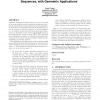Free Online Productivity Tools
i2Speak
i2Symbol
i2OCR
iTex2Img
iWeb2Print
iWeb2Shot
i2Type
iPdf2Split
iPdf2Merge
i2Bopomofo
i2Arabic
i2Style
i2Image
i2PDF
iLatex2Rtf
Sci2ools
181
Voted
COMPGEOM
2011
ACM
2011
ACM
On the structure and composition of forbidden sequences, with geometric applications
Forbidden substructure theorems have proved to be among of the most versatile tools in bounding the complexity of geometric objects and the running time of geometric algorithms. To apply them one typically transcribes an algorithm execution or geometric object as a sequence over some alphabet or a 0-1 matrix, proves that this object avoids some subsequence or submatrix σ, then uses an off the shelf bound on the maximum size of such a σ-free object. As a historical trend, expanding our library of forbidden substructure theorems has led to better bounds and simpler analyses of the complexity of geometric objects. We establish new and tight bounds on the maximum length of generalized Davenport-Schinzel sequences, which are those whose subsequences are not isomorphic to some fixed sequence σ. (The standard Davenport-Schinzel sequences restrict σ to be of the form abab · · · .)
Related Content
| Added | 25 Aug 2011 |
| Updated | 25 Aug 2011 |
| Type | Journal |
| Year | 2011 |
| Where | COMPGEOM |
| Authors | Seth Pettie |
Comments (0)

